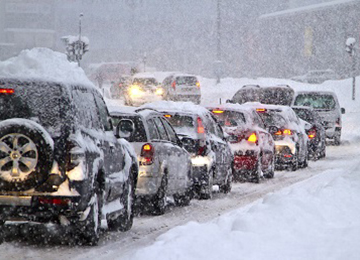Winter presents more diverse and severe safety challenges than any other season. Our homes, cars, and other machinery are less efficient in colder temperatures. Here are a few tips that can help you survive the winter safely.
Dress for the worst expected conditions: Dress using the multi-layer technique of several thinner layers as opposed to a single bulky layer. Start with garments that provide a wicking action to pull perspiration away from your skin. The second layer should for insulation. Your top layer should provide protection against wind and moisture. Don’t forget to use the same layering approach with your hands and feet, as they are most likely to sustain severe damage from exposure to the elements. Contrary to popular belief, it’s not true that you lose most of your body heat through your head; however, it is still important to protect your head and face from the cold.
Inspect and clean your heating system and fire place: Have your heating system inspected and cleaned each year; the same goes for your fireplace. If you use space heaters to supplement your normal heating system, do so with extreme caution. Space heaters are the 2nd leading cause of house fires. Turn your space heater off and unplug it when not in use.
Take care of your vehicle: Make sure your tires are properly inflated and have plenty of good tread before facing winter road conditions. Check the coolant level and make sure that anti-freeze is at the concentration recommended by your vehicle’s manufacturer. Having too little anti-freeze will quickly leave you stranded on the side of the road! Don’t forget to check your windshield wipers; replace them if they leave streaks. Make sure to top off your windshield wiper fluid reservoir with full-strength mixture; don’t thin it with water. Always carry an extra gallon in your trunk in case you need it when you’re on the road.
Keep an emergency kit in your car in case you do get stranded. It should include:
- Shovel
- Jumper cables
- Bag of salt or cat litter for better tire traction or to melt snow
- Tool kit
- Flashlight and extra batteries
- First aid kit
- Ice scraper and snow brush
- Nonperishable, high-energy foods like unsalted, canned nuts, dried fruits, and hard candy
- Blankets, extra gloves, socks, and hats
Stay Hydrated: Remember that you still need to stay hydrated when working or performing any type of physical activity outside. During cold weather you are less likely to realize that you are starting to dehydrate as the cold dulls the sensation of thirst. We still have water in the technician room refrigerator as well as Gatorade packets.
Stretch: Remember to stretch before performing physical activities. Cold muscles and joints are more prone to strains and injuries.
Notice the signs of Frostbite and Hypothermia: Remember that if the temperatures get extremely cold to watch for signs of frostbite and/or hypothermia.
- Frostbite: Painful, prickly or itching sensation, red, white or pale skin, hard or waxy- looking skin, cold or burning feeling and then numbness.
- Hypothermia: Uncontrollable shivering is the first sign of hypothermia! Seek someplace warm immediately!
With proper preparation and precautions you can help ensure that you stay winter safe and sound this winter.

